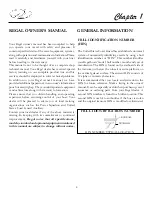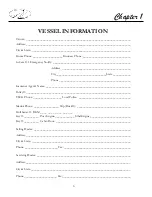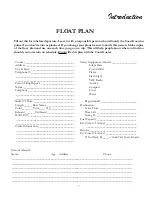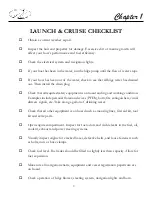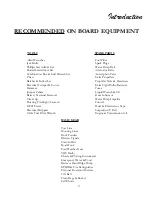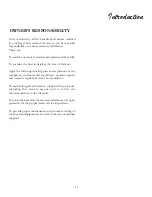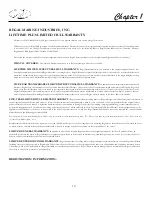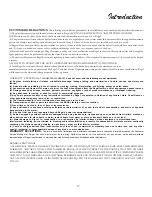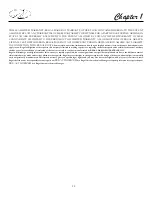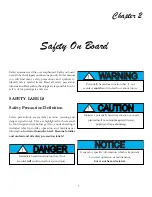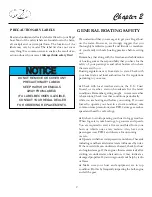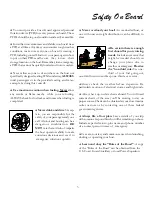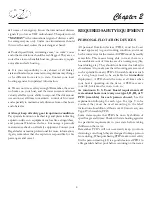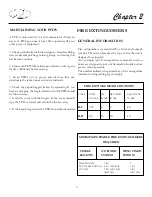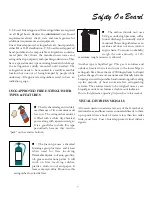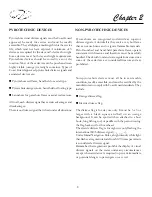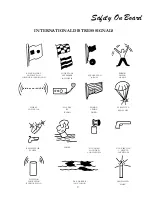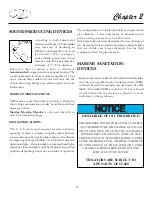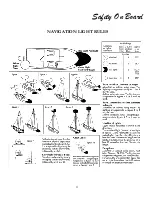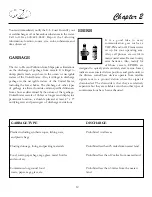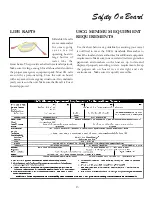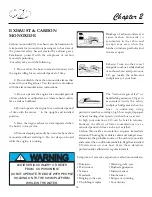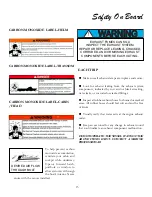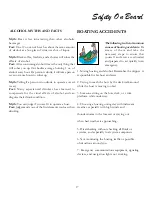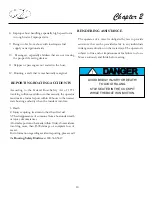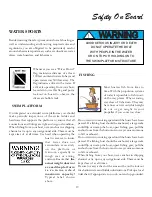
4
Chapter 2
♦
In case of emergency: Know the international distress
signals if you have a VHF radio aboard. The spoken word
“MAYDAY”
is the international signal of distress and is
for emergency use only. Under no circumstances should
this word be used, unless there is danger at hand.
♦
Posted speed limits, swimming areas, “no wake” zones
and other restrictions should be red-flagged. They are so
noted for a reason. Sensible boat use, plus courtesy, equals
enjoyable and safe boating.
♦
It is your responsibility to stay abreast of all federal,
state and local rules, as some laws or regulations may change
or be different from state to state. Contact your local
boating agencies for updated information.
♦
We can not stress safety enough!
Remember, there are
no brakes on your boat, and the water current and wind
velocity all affect your ability to respond. The driver must
use caution at all times to maintain control of his vessel
and especially to maintain a safe distance from other boats
and obstacles.
♦
Always keep all safety gear in optimum condition.
Pay special attention to attached tags and plates indicating
expiration dates on equipment such as fire extinguishers,
and personal flotation devices. Encourage a periodic
maintenance check on all safety equipment. Contact your
Regal dealer or marine professional for more information.
Again, remember that the captain is responsible for his
passengers and vessel.
PERSONAL FLOTATION DEVICES
All personal flotation devices (PFD’s) must be Coast
Guard approved, in good working condition, and must
be the correct size for the wearer. All PFD’s must be readily
accessible. This means being able to wear them in a
reasonable amount of time in case of an emergency (fire,
boat sinking, etc.). They should not be stored or locked in
closed areas Also, make sure that all coverings are removed
such as plastic from any PFD’s. Throwable devices such
as a ring buoys need to be available for
immediate
deployment. A PFD should be worn at all times when
your boat is operating on the water. A PFD may save
your life, but it must be worn to do so.
As minimum U. S. Coast Guard requirements all
recreational boats must carry one type I, II, III, or V
PFD (wearable) for each person aboard.
See the
explaination following for each type. For type V to be
counted they must be used according to the label
instructions. In addition, all boats over 16’ must carry one
Type IV (throwable) PFD.
Some states require that PFD’s be worn by children of
specific ages at all times. Check with state boating agencies
for particular requirements in your state before taking
children on the water.
Remember PFD’s will not necessarily keep you from
drowning, even though they are designed to keep a person
from sinking. When purchasing PFD’s make sure it safely
fits the person wearing it. It is a good idea to test PFD’s in
a lifeguarded shallow pool before venturing on the water.
REQUIRED SAFETY EQUIPMENT
Summary of Contents for 30 EXPRESS
Page 1: ...30 EXPRESS OWNER S MANUAL...
Page 2: ...784022 OWNER S MANUAL 30 EXPRESS 12 2012...
Page 30: ...11 Safety On Board NAVIGATION LIGHT RULES...
Page 41: ...Chapter 2 22 Notes...
Page 44: ...3 Rules Of The Road NAVIGATION RULES...
Page 85: ...28 Chapter 5 Notes...
Page 105: ...4 Chapter 7...
Page 106: ...5 Equipment Operation...
Page 107: ...6 Chapter 7...
Page 108: ...7 Equipment Operation...
Page 109: ...8 Chapter 7...
Page 110: ...9 Equipment Operation...
Page 111: ...10 Chapter 7...
Page 117: ...16 Chapter 7...
Page 126: ...25 Equipment Operation ROTARY ENCODER AND MENU KEY...
Page 127: ...26 Chapter 7 USING THE ROTARY ENCODER AND MENU KEY...
Page 158: ...57 Equipment Operation BACKING A TRAILER 1 2 3 4 LAUNCHING RAMP...
Page 161: ...60 Chapter 7 Notes...
Page 195: ...34 Chapter 8 Notes...
Page 204: ...9 Troubleshooting TOILET SYSTEM DIAGNOSTIC CHART...
Page 209: ...14 Chapter 9...
Page 219: ...6 Chapter 11 Notes...
Page 221: ...2 Chapter 12...
Page 224: ...5 Technical Information 30 Express Deck Overview 30 Express Cabin Overview...
Page 225: ...Technical Information 12 6 30 EXPRESS...
Page 226: ...12 7 Technical Information 30 EXPRESS...
Page 227: ...Technical Information 12 8 30 EXPRESS...
Page 228: ...12 9 Technical Information 30 EXPRESS...
Page 229: ...Technical Information 12 10 30 EXPRESS 30 EXPRESS...
Page 230: ...12 11 Technical Information TYPICAL NEGATIVE GROUND SYSTEM...
Page 231: ...Technical Information 12 12 30 EXPRESS...
Page 232: ...12 13 Technical Information 30 EXPRESS...

